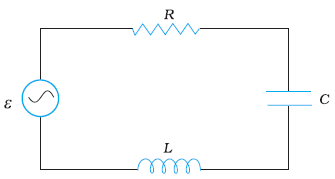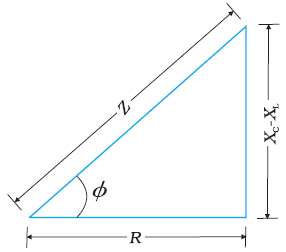
Calculate Power factor at the resonant frequency $f_0$.
Answer
573.6k+ views
Hint
The power factor is the cosine of the phase angle between voltage and current in an AC circuit. We will use the formula for the power factor in which phase angle is first determined. Resonance is a condition in an ac circuit according to which, capacitive reactance and inductive reactance are equal at a resonant frequency.
Complete step by step answer
We consider an LCR circuit consisting of a resistor, capacitor, and an inductor as shown in the figure.

The impedance is in analogy with the resistance in the circuit and is represented as,
$Z=\sqrt {R^2+(X_C-X_L)^{2}}$
Here, XC represents capacitive reactance i.e. the resistance of the capacitor to the flow of alternating current and XL represents inductive reactance i.e. the resistance of the inductor to the flow of alternating current.
The phase angle is determined using impedance diagram such that,

$cos \phi =\dfrac {R}{Z}$
Or $\cos \phi = \dfrac{R}{{\sqrt {{{\rm{R}}^2} + {{\left( {{{\rm{X}}_{\rm{C}}} - {{\rm{X}}_{\rm{L}}}} \right)}^2}} }}$
Power factor is the cosine of the phase angle implying that power factor is expressed by the relation,
Power factor $ = \dfrac{R}{{\sqrt {{{\rm{R}}^2} + {{\left( {{{\rm{X}}_{\rm{C}}} - {{\rm{X}}_{\rm{L}}}} \right)}^2}} }}$
Resonance is a common phenomenon among the ac circuit system that tends to oscillate at a frequency. At the resonance condition, the capacitive reactance and inductive reactance are equal i.e. ${{\rm{X}}_{\rm{C}}} = {{\rm{X}}_{\rm{L}}}$
For a non-inductive circuit that is an LCR circuit at resonance, the power factor is determined using,
$\cos \phi = \dfrac{R}{{\sqrt {{{\rm{R}}^2} + {{\left( {{{\rm{X}}_{\rm{C}}} - {{\rm{X}}_{\rm{L}}}} \right)}^2}} }}$
Since at resonance, ${{\rm{X}}_{\rm{C}}} = {{\rm{X}}_{\rm{L}}}$
∴ $\cos \phi = \dfrac{R}{R} = 1$
This implies that $\phi = 0^\circ $ and the power factor is one. Thus, maximum power is dissipated in a circuit through the resistance ‘R’ at resonance.
Therefore, $1$ is the required solution.
Note
This phenomenon of the resonance circuit is exhibited when both inductor and capacitor are present in the circuit. The resonant frequency is the oscillation of the system of an ac circuit at the condition of resonance.
The power factor is the cosine of the phase angle between voltage and current in an AC circuit. We will use the formula for the power factor in which phase angle is first determined. Resonance is a condition in an ac circuit according to which, capacitive reactance and inductive reactance are equal at a resonant frequency.
Complete step by step answer
We consider an LCR circuit consisting of a resistor, capacitor, and an inductor as shown in the figure.

The impedance is in analogy with the resistance in the circuit and is represented as,
$Z=\sqrt {R^2+(X_C-X_L)^{2}}$
Here, XC represents capacitive reactance i.e. the resistance of the capacitor to the flow of alternating current and XL represents inductive reactance i.e. the resistance of the inductor to the flow of alternating current.
The phase angle is determined using impedance diagram such that,

$cos \phi =\dfrac {R}{Z}$
Or $\cos \phi = \dfrac{R}{{\sqrt {{{\rm{R}}^2} + {{\left( {{{\rm{X}}_{\rm{C}}} - {{\rm{X}}_{\rm{L}}}} \right)}^2}} }}$
Power factor is the cosine of the phase angle implying that power factor is expressed by the relation,
Power factor $ = \dfrac{R}{{\sqrt {{{\rm{R}}^2} + {{\left( {{{\rm{X}}_{\rm{C}}} - {{\rm{X}}_{\rm{L}}}} \right)}^2}} }}$
Resonance is a common phenomenon among the ac circuit system that tends to oscillate at a frequency. At the resonance condition, the capacitive reactance and inductive reactance are equal i.e. ${{\rm{X}}_{\rm{C}}} = {{\rm{X}}_{\rm{L}}}$
For a non-inductive circuit that is an LCR circuit at resonance, the power factor is determined using,
$\cos \phi = \dfrac{R}{{\sqrt {{{\rm{R}}^2} + {{\left( {{{\rm{X}}_{\rm{C}}} - {{\rm{X}}_{\rm{L}}}} \right)}^2}} }}$
Since at resonance, ${{\rm{X}}_{\rm{C}}} = {{\rm{X}}_{\rm{L}}}$
∴ $\cos \phi = \dfrac{R}{R} = 1$
This implies that $\phi = 0^\circ $ and the power factor is one. Thus, maximum power is dissipated in a circuit through the resistance ‘R’ at resonance.
Therefore, $1$ is the required solution.
Note
This phenomenon of the resonance circuit is exhibited when both inductor and capacitor are present in the circuit. The resonant frequency is the oscillation of the system of an ac circuit at the condition of resonance.
Recently Updated Pages
A man running at a speed 5 ms is viewed in the side class 12 physics CBSE

The number of solutions in x in 02pi for which sqrt class 12 maths CBSE

State and explain Hardy Weinbergs Principle class 12 biology CBSE

Write any two methods of preparation of phenol Give class 12 chemistry CBSE

Which of the following statements is wrong a Amnion class 12 biology CBSE

Differentiate between action potential and resting class 12 biology CBSE

Trending doubts
What are the major means of transport Explain each class 12 social science CBSE

Which are the Top 10 Largest Countries of the World?

Draw a labelled sketch of the human eye class 12 physics CBSE

How much time does it take to bleed after eating p class 12 biology CBSE

Explain sex determination in humans with line diag class 12 biology CBSE

When was the first election held in India a 194748 class 12 sst CBSE




